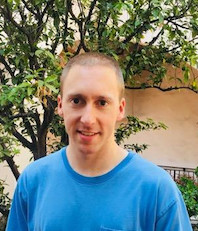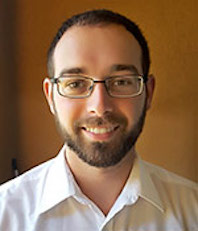-

Francesca Boscolo, PhD | Mentor: Marianna Alperin
Role of proteoglycans in determining muscle stem cell fate during pregnancy
Pelvic floor disorders (PFDs) are a major health issue given their high prevalence, negative impact on quality of life of millions of
women,and related economic burden. Maternal childbirth injury to the pelvic floor muscles (PFMs), confers the greatest hazard for subsequent PFDs. During vaginal childbirth, PFMs elongate beyond skeletal muscle’s physiological limit. Thus muscle injury should be expected to occur in most, if not all, vaginal deliveries; however, around half of women do not exhibit PFM injuries during childbirth. Using the validated rat model, we have previously shown that during pregnancy PFMs undergo protective adaptations, including fiber elongation through sarcomerogenesis. This process enables PFMs to withstand deformations during parturition with decreased susceptibility to mechanical birth injury. Muscle stem cells (MuSCs) are responsible for maintenance of muscle homeostasis, regeneration in case of injury, and adaptations to alterations in physiological cues. In pregnancy, pelvic MuSCs become activated by mid-pregnancy and then enter a newly identified state that we termed “pseudo-quiescence”. This novel MuSC state is characterized by phenotypically quiescent cells with concurrent high expression of activation-associated genes. To determine the molecular mechanisms involved in MuSC phenotypical changes, we analyzed PFMs’ extracellular matrix and showed dynamic quantitative changes in proteoglycans, such as fibromodulin, decorin, and lumican, throughout pregnancy, highlighting unique protein expression profile in mid- and late-pregnant compared to non-pregnant animals. These changes directly correlate with the phenotypic modifications observed in MuSCs. The current project aims to determine how changes in proteoglycan signature during pregnancy impact MuSC niche and govern pelvic MuSC fate. -

Patricia Lenhart-Pendergrass, MD, PhD | Mentor: Victor Nizet
Host Pathogen Interactions in Nontuberculous Mycobacterial Infections in Cystic Fibrosis
Nontuberculous mycobacteria (NTM) are a group of over 200 mycobacterial species, among which Mycobacterium avium is among the most common species known to cause human disease. NTM infections cause significant lung disease in susceptible hosts, including those with immunodeficiency or those with underlying structural lung disease including cystic fibrosis (CF). NTM infections are common in CF but are very challenging to diagnose and treat. Chronic neutrophilic inflammation is the hallmark of lung disease in CF. Several aspects of neutrophil biology have been studied in CF, however their role in NTM infection has been largely overlooked. Previous work has demonstrated that complement and antibody-dependent opsonophagocytosis are important aspects of the neutrophil response to M. avium and may be aberrant in CF. Additionally, numerous glycans are present in mycobacterial cell wells, but their role in host-immune interactions has not been thoroughly described. Future studies will evaluate which mycobacterial glycans may be targets for protective or non-protective antibody responses, the role of the lectin complement pathway in neutrophil killing of M. avium, and the impact of aberrant mucous glycosylation in host susceptibility to NTM infection.
-

Chelsea Painter, PhD | Mentor: Philip Gordts
Investigating the Role of Human Milk Oligosaccharides in Lipoprotein Metabolism and Hyperlipidemia
Cardiovascular diseases (CVDs) are the leading cause of death for people worldwide. Atherosclerosis is most common etiology of CVD. The pathology involves accumulation of immune cells and lipids in the arterial wall that leads to the hardening and narrowing of these arteries. Risk factors for atherosclerosis include elevated plasma lipids and cholesterol levels, known as hyperlipidemia and hypocholesteremia, respectively. Mouse models of hyperlipidemia, and hypocholesteremia develop atherosclerosis and are used as preclinical models to assess the effects of compounds on the development and regression of atherosclerotic lesions. Human milk is rich with bioactive compounds such as unconjugated oligosaccharides that exhibit diverse biological functions including regulating development and both innate and adaptive immunity. The diversity of monosaccharides, linkages, length, and branching leads to the production of over 150 structurally unique oligosaccharides in human milk. These individual glycans are being characterized for their distinct bioactivity and effects on biological systems. Preliminary research demonstrates that a specific human milk oligosaccharide (HMO) reduces atherosclerosis development when given subcutaneously in an atherosclerosis model and reduces plasma lipid levels when given orally in a hyperlipidemia model. While it is known that absorbed HMOs can have systemic effects, the mechanism behind the mitigation of hyperlipidemia by HMOs is unknown. We plan to investigate this mechanism by evaluating factors that affect plasma lipid levels such as lipid absorption in the gut, de novo triglyceride-rich lipoprotein production in the liver, lipid uptake in peripheral tissues, and lipoprotein clearance in the liver. We hope that these studies will elucidate the mechanism of action for this specific HMO in reducing hyperlipidemia in mouse models and provide evidence towards the use of HMOs in treating human diseases.
Career Development in Glycosciences | Scholars
Program Alumni
-

Phillip Bartels, PhD | Mentor: Yitzhak Tor
Targeting Neuronal Degeneration in Gaucher Diseasese
Gaucher Disease (GD) is a lysosomal storage disorder caused by homozygous mutations in the GBA gene, which encodes the enzyme glucosylceramidase (GCase) responsible for the final step in glycosphingolipid degradation. Two forms of GD are neurodegenerative and have been linked to an elevated risk of Parkinson’s Disease (PD). Notably, heterozygous GBA mutations that do not cause GD are also a risk factor for PD. Non-neurodegenerative GD can be treated by enzyme replacement therapy using intravenously delivered recombinant GCase, but the brain is not readily accessible through this route. To target neurodegenerative GD and PD, we plan to use the small molecule Guanidinylated Neomycin (GNeo) to enhance GCase uptake and delivery to the brain. GNeo binds cell surface heparan sulfate and facilitates uptake and lysosomal delivery of molecular cargoes, including proteins. Indeed, previous work using intranasal delivery in mice showed that GNeo-iduronidase conjugates enter the brain to a much greater extent than unmodified enzyme. The plan for the current project is to prepare NHS-modified GNeo for conjugation to exposed lysine residues on recombinant GCase, and then use the GNeo-GCase conjugates to treat human Gaucher fibroblasts and neurons obtained from a mouse model of Gaucher disease. Cell uptake will be confirmed using activity assays performed in cell lysates along with direct visualization in cultured neurons using a fluorophore-modified form of GNeo. At this point, both NHS-GNeo and recombinant GCase have been successfully prepared and the conjugation reaction has been optimized. Conjugates retain full enzymatic activity, and plans to treat cells are imminent.
-

Julia Callender, PhD | Mentor: Christina Sigurdson
Manipulating PrP glycan structure to understand toxic signaling pathways driving prion-induced neurodegeneration
Prions cause a rapidly progressive neurodegenerative disease characterized by an exponential increase in prion aggregates as well as a spongiform encephalopathy, dystrophic neurites, and neuronal death. These processes depend on the neuronal expression of the cellular glycoprotein, prion protein, PrPC, however, the mechanism through which PrP signaling or aggregation contributes to neurodegeneration remains unclear. Previous work has shown that glycan modifications may impact PrP aggregation and neuronal toxicity. To investigate the role of glycans in prion-induced toxicity, we have engineered a new knockin mouse model introduces an additional glycan on the amino terminus of PrP. This mouse develops spongiform encephalopathy in the absence of PrP aggregates, thus uncoupling PrP aggregation from neurotoxicity. Here we will use this new mouse model to investigate the mechanism through which PrP glycans contribute to prion-mediated neurotoxicity and neurodegeneration.
Achievements:- Received poster award at Society for Glycobiology conference, November, 2020
- Award received for abstract at UCSD Pathology Department Research Retreat, August 15, 2020
- Award received for abstract at the NIH/FDA Glycoscience research day, May 15, 2020
-

Dillon Chen, MD | Mentor: Ajit Varki
Characterize the functions of human polysialic acid and Sialic-acid binding immunoglobulin-type lectin (Siglec) receptors
Sialic acd-binding immunoglobulin-type lectins (Siglecs) belong to a class of self/non-self-recognition immune receptor. There can be activated by sialic acid, including polysialic acid. Siglecs- 11 and -16 are paired receptors with homologous extracellular binding domains, but have divergent intracellular signaling pathways. Siglec-11 contains the classical immunoreceptor tyrosine inhibitory motif (ITIM) and leads to immune inhibition when activated. On the contrary, Siglec-16 engages DAP12 binding partner, which contains the immunoreceptor tyrosine activating motif (ITAM) and leads to immune activating. Siglecs -11 and -16’s expression in the human is uniquely human and they each have other uniquely human properties. Little is known about how these unique human features affect their function. In my studies, I hope to characterize how polysialic acid and the distinctly human features of the Siglecs -11 and -16 affect their function.
-

Sun-Mi Choi, MD, PhD | Mentor: Victor Nizet
Upper airway mucosal responses to MRSA in CRS
Chronic Rhinosinusitis (CRS) affects 10% of adults and Staphylococcus aureus (SA) colonization is increased in CRS. One hypothesis to delineate the role of SA in pathogenesis of CRS is that SA stimulates production of c-type lectin Reg3g which binds to peptidoglycan layer of Gram+ bacteria along with type 2 inflammatory cytokines (thymic stromal lymphopoietin [TSLP] and IL-33) that causes hyper production of mucins (Muc5AC and Muc5B) resulting in chronic inflammatory state involving aberrantly activated innate immune and T cells.
Achievements:
Received scholarship from Western Society of Allergy, Asthma & Immunology Emerging Allergist -

Michelle Ducasa, PhD | Mentor: Philip Gordts
The role of heparan sulfate proteoglycans in non-shivering thermogenesis
The present worldwide obesity epidemic is associated with a sharp increase in its metabolic complications, including a dramatic surge in Type 2 Diabetes. Increasing energy expenditure has emerged as an approach to treat obesity. Most of this energy expenditure takes place in mitochondria, where energy is generated through the electron transport chain, which creates a proton gradient across the inner membrane to drive the synthesis of ATP. This process can be uncoupled, resulting in the consumption of energy and generation of heat. Thermogenic uncoupling of mitochondrial oxidative phosphorylation is largely but not exclusively mediated by the thermogenic protein UCP1 in brown and beige fat. Activating and recruiting brown and beige fat is a major pharmacological focus for obesity and the associated metabolic disorders. Previous studies have shown that heparan sulfate proteoglycans (HSPG) play a role in insulin sensitivity and adipocyte differentiation. Their role in cytokine and growth factor presentation and their abundance in the extracellular environment place HSPGs in a unique position to modulate adipocyte phenotypes. Thus, the goal of this project is to understand if heparan sulfate proteoglycans contribute to adipose tissue plasticity and thermogenic potential.
-

Graham Heberlig, PhD | Mentor: Michael Burkart
Structural examination of lipid A biosynthesis complexes
Lipid A, also known as endotoxin, is a glucosamine based saccharolipid essential for the growth of most gram-negative bacteria. It serves as a hydrophobic anchor for lipopolysaccharide (LPS) which is required for virulence. Lipid A is biosynthesized via the Raetz pathway which intersects with fatty acid biosynthesis (FAB) through the incorporation of 3-hydroxy-acyl chains donated by acyl carrier proteins (ACPs). Chemical synthesis of ACP-linked probe molecules will facilitate structural (re)characterization of the four ACP-acyltransferase complexes required to generate mature Lipid A. These structural studies may provide new strategies toward antibiotic and vaccine development.
-

Sridevi Krishnan, PhD | Mentor: Nathan Lewis
Nutrition and cardiometabolic disease: A systems biology based multiomic investigation
Diet, exercise, and lifestyle habits strongly influence the onset and management of chronic cardiometabolic diseases including type 2 diabetes and cardiovascular disease. Diet, via its effects on the gut microbiome, can alter glycosylation of the intestinal epithelial cells. Also, dietary fiber can increase circulating short-chain fatty acids (propionate, butyrate, and acetate), which act as histone deacetylase inhibitors. These histone deacetylase inhibitors can epigenetically modify cellular glycosylation, thus influencing the type and number of sugars/glycans post-translationally added to proteins. The glycan structure and composition can affect both protein structure and function, implying a potential link between diet composition and pathology that remains poorly understood. In a randomized controlled feeding trial done in collaboration with scientists at the USDA, specific circulating hepatic-origin proteins that are associated with type 2 diabetes or hypertension (E.g.: angiotensinogen, AGP1, Kallikrein, A2MG) were evaluated using a targeted site-specific LC-MS/MS protocol in adult women with one or more metabolic syndrome characteristics. In this study, consuming a 'healthy' diet (higher in dietary fiber, including more whole grains, fruits, vegetables, dairy, and rich in omega-3 fatty acids) for 8 weeks resulted in increased sialylation compared to the less 'healthy' diet. Further, consuming more refined grain (processed flour) was associated with greater fucosylation. The circulating lipidome (fatty acids, phospholipids, acylcarnitines) was also measured before, during, and after the intervention. The proposed follow-up study, which will leverage the computational biology expertise in the Lewis lab, will use systems biology approaches to integrate the multi-omic data and identify causal links between diet patterns and metabolic disease phenotypes based on clinical outcomes (fasting and postprandial glucose, lipid profile, blood pressure, endothelial function). Further, glycoinformatics tools that allow for deeper investigation of the glycan biosynthesis pathway, will be used to further our comprehension of the link between glycosylation and cardiometabolic disease.
-

Ryan Porell, PhD | Mentor: Kamil Godula
Design and synthesis of heparan sulfate macrophage-targeted glycopolymer mimetics to reprogram tumor microenvironments
Cancer cells demonstrate a unique ability to evade and manipulate immune cells into assisting their proliferation and metastasis through the secretion of growth factors (GFs) and anti-inflammatory cytokines. Heparan sulfate proteoglycans (HSPGs) engage and act as reservoirs for several tumor-proliferative GFs and immune suppressive cytokines. High heparinase expression in tumor microenvironments induces release of these factors to accelerate tumor severity. My research involves synthesizing HS-mimetic nanomaterials, which sequester GFs and cytokines back from cancer cells. These HS-mimetics also contain lysosome targeting glycans (mannose), which transport the HS-mimetics with bound GFs to macrophage lysosomes, thus eliminating them from the tumor microenvironment. Our synthetic mannosylated targeting polymers engage macrophage mannose receptors (CD206), internalize to lysosomes, and slightly activate macrophages based on cell surface phenotype markers. The challenge of attaching full HS chains or HS disaccharides to our mannosylated polymers motivated me to take an alternative approach with a modular design making separate mannosylated-cyclodextrin and HS-adamantane molecules, which engage through host-guest interactions. Analysis of our host-guest designed bifunctional glycopolymers is currently underway. We hypothesize that our multifaceted approach focused on degradation of growth and immune suppressive factors with concomitant immune activation will become a powerful technique towards thwarting cancer proliferation and metastasis.
-

Richard Sanchez, PhD | Mentor: Gulcin Pekkurnaz
O-GlcNAc dependent cytoskeletal influences on mitochondrial localization under varying cellular metabolic states
Intracellular O-GlcNAc is a single unelongated glycolytic molecule that is added on to proteins as a post-translational modification (PTM) on serine and threonine residues. The enzymes responsible for the addition and removal of O-GlcNAc are O-GlcNAc Transferase (OGT) and O-GlcNAcase (OGA) respectively. In eukaryotes OGT is a major nutrient sensing enzyme that is expressed in every cell type but is most abundantly expressed in the brain and pancreas. OGT’s catalytic activity is regulated by intracellular concentrations of UDP-O-GlcNAc which is synthesized by varying metabolic substrates through the hexosamine biosynthesis pathway allowing its concentration to fluctuate in response to nutrient availability. Our lab has shown that OGT can regulate mitochondrial localization and metabolic efficiency in neurons. Expanding upon these results we have identified cytoskeletal regulating protein candidates that are susceptible to O-GlcNAcylation using mass spectrometry on isolated neuronal mitochondria. My focus will be on the role of these cytoskeletal proteins in the context of mitochondrial positioning and metabolic compartmentalization under the influence of O-GlcNAcylation. In addition, even though OGT is a single gene it codes for three splice isoforms all of which are capable of O-GlcNAcylating proteins. I will define which OGT isoforms are influencing metabolic efficiency. Overall, these studies will provide a more comprehensive understanding of the metabolic regulatory factors that influence cellular metabolic homeostasis, helping in elucidating human metabolic disorders that range from diabetes to neurodegeneration.
-

Ruth Siew, MD | Mentor: Victor Nizet
Sialic acid interactions in cystic fibrosis
Cystic fibrosis is caused by a mutation in the CFTR gene that results in a multi-organ system disease with the primary cause of morbidity from severe, chronic respiratory infections. The opportunistic pathogen, Pseudomonas aeruginosa, is an early colonizer of the cystic fibrosis lung and causes inflammation and structural lung damage. It produces sialidase as a pathogenic virulence mechanism where desialylation of the airway mucosal surface allows for the colonization of P. aeruginosa and biofilm formation. There has been limited research in the area of bacterial sialidase as it contributes to the pathogenesis of infection, therefore I am interested in further exploring bacterial sialidase as it relates to the host immune system. CFTR function has also been linked to the sialic acid N-glycolylneuraminic acid (Neu5Gc), which differs from the human-dominant form N-acetylneuraminic acid (Neu5Ac) by one oxygen atom due to lack of the enzyme CMP-N-acetylneuraminic acid hydroxylase (CMAH). I seek to understand how this difference applies to lung epithelial cells with the CFTR mutation. As the Varki lab has had extensive experience with this glycosylation change from Neu5Gc to Neu5Ac, they have also been successful in recapitulating a cholera-like phenotype in a mouse model using a Cmah null mouse. There are currently no mouse models available that have been able to simulate chronic lower respiratory tract infections such as those seen in humans. By crossing the Cmah mouse line with the most common mutation in cystic fibrosis (CFTR delF508), I hope to create a humanized mouse model of disease for cystic fibrosis.
-

So-Young Kim, PhD | Mentor: Mark Fuster
Glycosaminoglycan-based lung cancer immunotherapy
Lung cancer is the leading cause of cancer death in the U.S. and worldwide. Dendritic cells (DCs) recognize tumor antigen and instruct T cells to initiate antitumor immunity. In a tumor microenvironment, however, dendritic cells are suppressed from properly expressing mature phenotype to carry on this function. Heparan sulfate (HS) glycosaminoglycan, when altered on the DC surface, restores mature DC phenotype and inhibits immature DC trafficking to the draining lymph nodes demonstrating anti-tumor therapeutic potential, however, its effect on T cell associated lung cancer immunity has not been previously investigated. In my studies, I will uncover how DC specific HS alteration will influence the antitumor associated T cell function and downstream signaling pathways. Additionally, genetic and chemical strategies will be developed targeting DC HS.
-

Ryan Weiss, PhD | Mentor: Jeff Esko
CRISPR-Cas9 Dissection of Heparan Sulfate
Heparan sulfate proteoglycans (HSPGs) are expressed on all animal cells and in the extracellular matrix. Each HSPG consists of a core protein with one or more covalently attached linear heparan sulfate (HS) chains composed of alternating glucosamine and uronic acids that are heterogeneously N- and O-sulfated. These complex cell surface carbohydrates regulate important biological processes including cell proliferation and development through their interaction with many matrix proteins and growth factors. The arrangement and orientation of the sulfated sugar residues of HS specify the location of distinct ligand binding sites on the cell surface, and these modifications can vary temporally during development and spatially across tissues. While most of the enzymes involved in HS biosynthesis have been studied extensively, less information exists regarding the mechanisms that give rise to the variable composition and binding properties of HS. The overall goal of this project is to understand the genetic factors that control the formation of heparan sulfate in mammalian cells. A genome-wide CRISPR/Cas9-mediated screen will be developed to uncover novel genes other than those encoding known HS biosynthetic enzymes. A lentiviral single guide RNA (sgRNA) library will be utilized to knock down gene expression across the entire genome in a human cancer cell lines. Subsequently, a high-throughput screen will be adapted to identify sgRNAs that induce resistance to cytotoxins whose action depends on HSPGs or decrease binding of HS-dependent ligands to the cell surface. Overall, these studies will provide a better understanding of the genetic regulatory factors involved in HS biosynthesis, as well as lead us to methods to manipulate HS and its activities in other cellular processes that go awry in human diseases.
